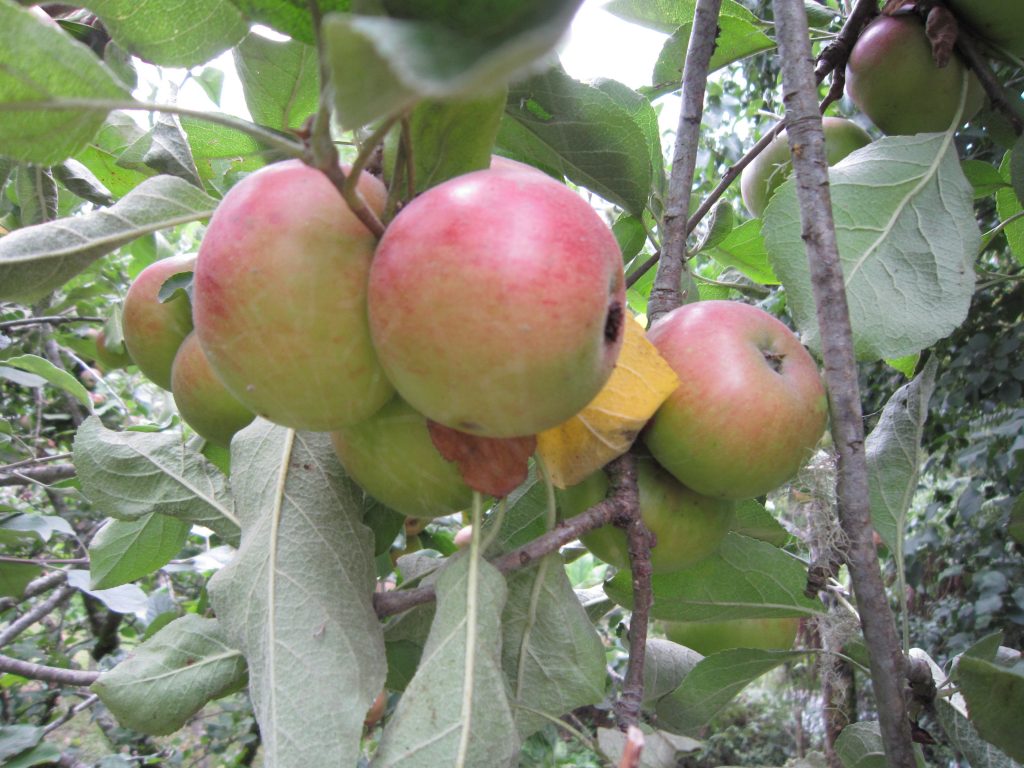Every year, when the apples are ripening and falling off the trees faster than they can be eaten or bottled or given away it’s the time to turn some of them into apple cider vinegar. Apple Cider vinegar is touted as an amazing cure-all by many. Unfortunately there is a dirth of research, yet I believe that if nothing else is it is undoubtedly the healthiest vinegar out of all vinegars available. Apple cider vinegar should have a dark cloudy sediment, which is called ‘the mother’ and is the mark of an unfiltered and unpasteurised vinegar. That’s what we are looking for. Vinegar is the product of a fermentation process and we want the good bacteria alive and kicking. They do the good work in our gut. Unpasteurised cider vinegar has been shown to lower blood glucose levels, and to bring the body into a more alkaline state. This is something most of us need to consider as most of our diets, often heavy in processed foods, meat, grains and dairy tend to create an acid situation in our bodies which can cause lack of energy, excess mucous, infections, depression, headaches, irritability, and, make some of us prone to arthritic and gouty conditions. It is recommended to take one or two tablespoons of the vinegar in a small glass of warm water first thing in the morning before eating. If you can’t manage that then anytime is better than no time!
In our family our homemade vinegar is always the first ingredient selected for a vanaigrette dressing. We have a lot of people coming through the home and salads are usually a component of the main meal. Without fail just about everyone who eats our salads for the first time asks how we make the dressing, because they are so yummy. In a jar put some apple cider vinegar, olive oil, crushed garlic a little honey and salt and pepper. Put the lid on and shake till well-combined. As you can see there is nothing to it, so maybe it is our own vinegar that imparts the x factor.
TO MAKE APPLE CIDER VINEGAR.
All you need is;
an electric juicer
some clean glass bottles (I have saved some of the old half gallon bottles)?
a few pieces of cotton fabric and some rubber bands.
A warm dark cupboard and some patience

Gather your apples. They need to be fully ripened so that they are sugar rich…this is what is broken down by bacteria and yeast in the fermentation process and converted into alcohol and then into vinegar.
Wash or wipe and chop removing bugs and impurities so that they can be put through your juicer.
Juice the prepared apples.
Pour the apple juice into glass bottles and cover the tops properly with a few layers of cotton cloth. Something that can breathe and release the gaseous products of fermentation. I tightly wind rubber bands around the neck to hold the cloth firmly. You want the gas to get out but you don’t want any little fruit flies that will be attracted to the smell, to get into the bottles.
Now place your start up vinegar into a cupboard where you can leave it undisturbed for up to a year. The juice may be quite cloudy when put down but as the time passes the juice will be transformed into a clear and beautifully coloured liquid. It pays to check the bottles every now and again. One year some little critter chewed through the cloth and the bugs got into the vinegar. When you can see that the fermentation process is complete, there will be a clear liquid on top and a heavy sediment on the bottom, very gently strain the clear liquid off ?into another glass bottle. Seal with a regular lid and your very own naturally fermented apple cider vinegar is ready for consumption. See Make your own cider vinegar Part two for Pictures
Which apples can you use? It pays to use late season apples that are well ripened with strong or sharp flavours. A few years ago I made lots of different vinegars by using different apples for each batch instead of mixing them all up. The results were varied, some were bland and tasteless while others were well-flavoured. There are special varieties for vinegar making. I don’t have any growing here but hmmm I might think about getting one this autumn.
There are other methods of fermenting apple cider vinegar, using heat and yeast but personally I prefer this slow and time-honoured process. I hope you enjoy both the process and the results as much as I do. Good health!
Jean, it is well worth the effort, Make sure and use the right apples though, fully ripened and flavoursome. I am still putting down a gallon a week, until my apples trees have finished producing